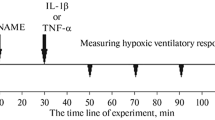Abstract.
The effects of two vasoactive agents (adenosine A2A agonist, CGS 21680, and adrenoceptor agonist, noradrenaline) were examined on cardiac output (CO), heart rate (HR), blood pressure (BP), mean circulatory filling pressure (P mcf), resistance to venous return, arterial resistance, dP/dt, plasma levels of NO2 –/NO3 –, and inducible nitric oxide synthase (iNOS) activity in lungs ex vivo, following treatment with tumour necrosis factor-α (TNF-α; 30 µg/kg) in anaesthetized rats. Treatment with TNF-α produced significant reduction in CO (41±2%), dP/dt (26±3%), BP (26±2%) and P mcf (27±4%; n=6; mean±SEM), but increased arterial resistance. There were no significant changes in the plasma levels of NO2 –/NO3 – levels over time following treatment with TNF-α, but there was a significant increase (approximately twofold) in the activity of the iNOS in the lungs of animals treated with TNF-α. Administration of CGS 21680 (1.0 µg/kg per min) significantly increased CO (44±6%), HR (12±2%), P mcf (24±4%) and dP/dt (24±5%) in TNF-α-treated rats. CGS 21680 also significantly reduced arterial resistance (33±2%) without altering resistance to venous return in TNF-α-treated rats. While noradrenaline (1.0 µg/kg per min) infusion did not significantly increase CO, it did significantly increase HR (12±1%), BP (55±9%), P mcf (47±5%), dP/dt (65±7%), resistance to venous return (64±20%), and arterial resistance (41±16%) in TNF-α-treated animals. The reduction in BP due to administration of TNF-α is the result of significant reduction in CO. Consequently, the decline in CO can be attributed to a combination of a negative inotropic effect as well as a reduction in P mcf. It is evident that infusion with CGS 21680 could reverse the negative impact of TNF-α on CO by increasing dP/dt, P mcf and HR as well as a reduction in arterial resistance. The fact that noradrenaline did not significantly increase CO in TNF-α-treated rats can be attributed to increased arterial resistance as well increase in resistance to venous return.
Similar content being viewed by others
Author information
Authors and Affiliations
Additional information
Electronic Publication
Rights and permissions
About this article
Cite this article
Tabrizchi, R. The influence of tumour necrosis factor-α on the cardiovascular system of anaesthetized rats. Naunyn-Schmied Arch Pharmacol 363, 307–321 (2001). https://doi.org/10.1007/s002100000374
Received:
Accepted:
Issue Date:
DOI: https://doi.org/10.1007/s002100000374




